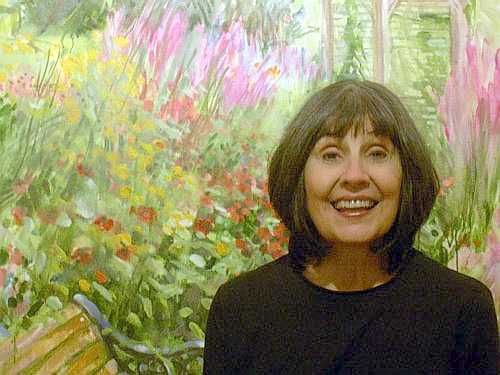One of a recognizable, yet small, cache of local
plein air or, outdoor, painters living and
working in Fort Wayne, Karen Moriarty stands out
as an inner-directed, Zen-like chronicler of the
outdoors and the subtleties of nature who has
found success in several other areas of
expression. Her impressionist portraits of
gardens and natural scapes are widely collected
and appreciated along with her painted portraits
and lithe nudes, but she also charts places in
unconventional directions as she has within her
own life.
Nicknamed “Apple” by friends because of her
affinity and predilection to flora and
phototropism, the sixty-ish Moriarty renders what
she sees with an accurate eye and an intuitively,
deft technique. The girl’s got “hand,” as they
say.
“Some things are directed simply by the medium,”
she says of her various works that encompass
commercial, graphic and illustrative works which
even include courtroom-driven pieces. “If you’ve
got charcoal or a prisma colored pencil in your
hand, you’re directed to scale down the vision.
On the other hand, with a brush and an oil
palette, your canvas and vision expands from
being finger- and wrist-rendered to the kinetic
sweep of the whole arm.
“Gardens, flowers, the woods, the human figure,
they all attract my attention because they are of
nature. They each contain lines and elements that
are simple, elegant and sometimes they are even
organically complex.”
What appeals to me more than the substance of
Moriarty’s work is the style and sub text which
influences and guides its creation. Her intuitive
hand, or line, evokes a kind of rhythmic gesture,
as when she paints flowers that appear to glow
from within as they sway in the wind, reflecting
the changing sunlight. When she draws nudes her
hand seems more of an exact, life-form tracing
than an interpretation. She’s able to incorporate
the energy of the animate.
“It’s about getting it right,” Moriarty says,
“and that is a matter of training, vision and
centering.”
To explain her point the artist gives an example
of a Japanese artist she remembers from a PBS
show. “He is pictured standing silent, stoic and
still before a canvas.
“He stood there, reverent and meditative, for
more than a moment – his landscape or target in
crisp focus. Then he bowed, hand-clasped to the
subject. In an instant he exploded with his brush
upon the canvas, and within seconds he had
rendered his subject in its most minimal,
essential form. The artist channeled the energy
of himself and the subject within that moment,
and all within the blink of an eye! I admire and
aspire to that.”
Pretty heady for a girl who first discovered her
talent at a birthday party in Goshen when she was
five. “There was some kind of a contest at a
birthday party where we were to finish a drawing
in a coloring book with crayons. The setting was
in a garden, and I won the first prize. I’m not
sure why I won. Was it because I stayed within
the lines or because I went out of the lines? I
still think about that. It brought me a kind of
recognition and encouragement, and I’ve never
really stopped.”
After high school, where she edited the school
yearbook and learned about the processes of
publishing, writing and editing, she ended up at
the Fort Wayne Art School, where she studied
under Noel Dusenchon, John Ross, Russell Oettel,
Ruth Gibson and Forrest Stark.
From then up to the present Moriarty continues
to work variously as a freelance graphic
designer, interior designer and television
courtroom artist, all the while plying her
paintings and drawings through the Castle
Gallery, Artlink, the Fort Wayne Museum of Art
and via word-of-mouth.
Throughout her freelance career Moriarty has
dwelt on the leading edge of technology, and her
experience and knowledge provides a living
testament to the modern evolution of the graphic
arts.
“People today aren’t aware of the processes we
went through to produce printed projects,”
Moriarty says. “It’s simply amazing what has
evolved over a couple of decades. What can be
accomplished today with a mere couple of
keystrokes used to entail buckets of hours of
tedious hand-cutting with a mat knife [one for
each of four color separations] or hand-setting
type [individual letters were applied either by
cutting them out of a sheet and positioning them
or applying them via transfers]. Obviously it has
become easier, more accessible to many, but I
still, in certain circumstances, choose to do my
logos with Letraset.”
Moriarty’s lush paintings of today (Foster Park,
Lakeside and private gardens) seem derivative of
a master like Cezanne, but other self-admitted
influences in composition and style can be traced
to her former Fort Wayne Art School teacher
Oettel and the California painter Richard
Diebenkorn.
The artist also pays homage to two diverse
modern women painters, Jennifer Bartlett and Joan
Mitchell, although to my mind it is hard to find
a direct connection between the three of them.
But then that’s Moriarty and a part of her own
surprising nature. It’s one of her traits to
always be between things. Not a bad place to be
for it is in that realm that things come
together, exchange and expand.
As one would imagine, Moriarty is a founding
Three Rivers Food Co-Op member, frequents the
Cinema Center and confesses to liking all music.
She listens to Julia Meek on WBOI, plays old
editions of the Beatles and Rolling Stones along
with Ella Fitzgerald and currently enjoys all
“those breathy, angry, feminist girls” who talk
the talk.
In her latest incarnation Moriarty has embarked
on a new avenue that uses found objects like
wooden framed windows on which she paints flowery
scenes on the glass that incorporate the frames
as well.
The result is an amalgam of her tendencies
toward plein air and interior design. It is a
medium that suits her style and will most
certainly provide a portal into her next artistic
adventure.

